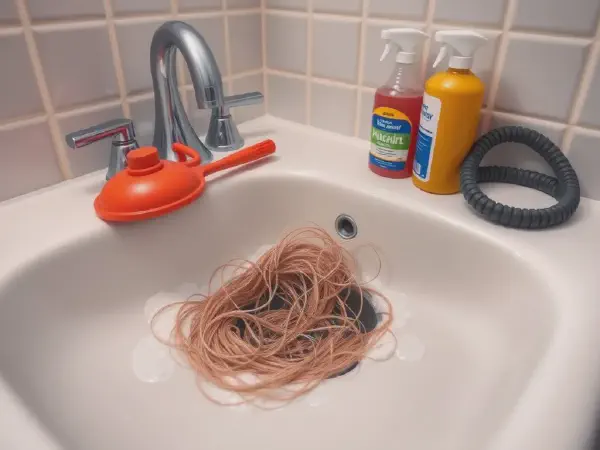Top Common Causes of Hair Clogs and Effective Solutions

Understanding Hair Clogs: Formation, Prevention, and Impact
Hair clogs are a common plumbing issue that many homeowners encounter. These obstructions, caused predominantly by loose hair, can accumulate over time and lead to slow drainage or complete blockages in sinks, showers, and tubs. Understanding the nature of hair clogs and how to address them is essential for every homeowner.
When hair collects in plumbing systems, it can lead to a number of issues. Not only can these clogs cause inconvenience due to slow or obstructed flow, but they can also result in more serious plumbing problems if left unaddressed. This article will explore the formation of hair clogs, prevention methods, and the impacts they can have on your home's plumbing system.
Hair clogs can occur in any area of a home that experiences water drainage, with bathrooms being the most common location. Whether it's long strands of hair shedding while you wash, or hair falling into sinks during grooming, the accumulation can contribute to significant blockages over time. Additionally, these clogs can often be exacerbated by other debris such as soap residue and grease.
Beyond the inconvenience they cause, hair clogs can lead to increased plumbing maintenance costs and a need for more extensive repairs if the issue becomes severe. Understanding the signs and implications of hair clogs is crucial in mitigating their effects and saving on plumbing bills.
This comprehensive article will delve deeper into the formation, prevention, and overall impact of hair clogs, equipping you with the knowledge needed to keep your plumbing system running smoothly.
Formation of Hair Clogs
Hair clogs form when strands of hair accumulate in drains and pipes, often intertwining with other particles like soap scum, grease, and dirt. Over time, these materials can create a dense mass that restricts water flow. The longer hair remains in the drain, the more it can catch other debris, further exacerbating the clog.
The impact of hair on plumbing systems can be significant. A hair clog can lead to slow drainage, backflow, and even burst pipes if water pressure builds up behind the obstruction. In older plumbing systems, the risk of damage increases as pipes degrade under the stress of constant water pressure and blockages.
Common household causes of hair buildup include daily hair washing, grooming habits such as brushing or combing hair over sinks, and improper disposal of hair in toilets or drains. Shower drains are particularly susceptible, especially in households with long-haired individuals.
Preventing Hair Clogs
One of the best practices for managing hair in bathrooms is to encourage family members to be more conscious of hair shedding. Simple habits, like brushing hair before showering or styling, can significantly reduce the amount of hair washed down the drain.
Using drain covers and filters can provide an effective barrier against hair clogs. These inexpensive devices can trap hair and other debris, preventing them from entering the drain while still allowing water to flow freely. Regular cleaning of these covers is essential to ensure functionality.
Regular maintenance, such as flushing drains with hot water, can help dissolve soap scum and grease that may bind with hair. Storing a drain cleaning tool under the sink can also be useful for any immediate clogs that may occur, enabling prompt action before the situation worsens.
Addressing Existing Hair Clogs
When hair clogs occur, there are several tools and methods available for clearing them. Plumbing snakes and drain augers are effective tools for reaching deep clogs, while specialized hair removal tools can be used for surface-level blockages.
Homeowners often have to choose between chemical and natural drain cleaners. While chemical options can be effective, they also carry the risk of damaging pipes and harming the environment. Natural drain cleaners, such as a mixture of baking soda and vinegar, can be a safer alternative for breaking down hair clogs without harsh chemicals.
Knowing when to call a professional plumber is crucial. If efforts to clear the clog fail or if there are recurring issues, it’s best to consult a professional. Persistent clogs could indicate more serious underground issues that need expert attention.
Impact of Hair Clogs
The potential damage caused by hair clogs can vary from minor inconveniences to significant plumbing failures. Over time, if not managed properly, hair clogs can lead to damaged pipes, necessitating expensive repairs or even full replacements.
Health implications of clogged drains can arise due to stagnant water, which can become a breeding ground for bacteria, mold, and other pathogens. This not only poses a risk to the residents of the home but can also lead to unpleasant odors and hygiene issues.
The environmental impact of chemical drain cleaners is another consideration. Many commercial products contain harsh chemicals that can contaminate water systems and harm aquatic life. Opting for natural cleaning methods can help reduce this environmental footprint.
Hair Clogs Myths
Common misconceptions about hair clogs include the belief that the occasional shedding of hair won't cause significant issues. However, regular maintenance is essential, as even small amounts of hair can build up over time.
Myths vs. facts on drain maintenance often lead people to underestimate the impact of hair clogs. For instance, many believe that flushing drains with hot water alone is sufficient to prevent clogs, while in fact, proactive measures are necessary to truly keep drains clear.
Misunderstood prevention methods can also lead to issues. While some people think that chemical cleaners can solve all clog problems, relying on them without proper maintenance can lead to larger issues in the long run.
